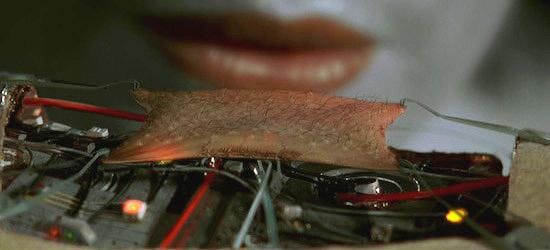Published Feb 2, 2015
TREKNOSIS: Skin In the Game
TREKNOSIS: Skin In the Game

April 4th, 2063: It's the day before the Vulcans make First Contact with the people of Earth, and the USS Enterprise NCC 1701-E happens to be on hand for the occasion. Also along for the ride are some uninvited guests: the Borg, determined to derail history and led by their Queen, who's set up shop in main engineering and is recruiting aggressively to say the least. Having captured Lieutenant Commander Data, the Borg Queen sets her sights on making him a willing part of the Collective; her highly-personalized campaign seems to hit its stride when she replaces a portion of his android skin with the more traditional biological model, treating him to new and different sensations — like goose bumps.

Skin grafts are nothing new, of course — if you're talking about putting them on top of living flesh. But grafting organic skin onto something synthetic is whole other kettle of cybernetic fish. Where would you find a willing donor? How do you supply nutrients to the layer of tissue you've slapped onto a slab of cold metal and plastic? Even Data himself cautioned that you’d eventually have to deal with "the problem of increased signal degradation inherent to organosynthetic transmission."
This makes for a less-than-sunny outlook for people with prosthetic limbs who'd like to be able to feel things again. It isn't just a quality-of-life matter, either; if you've got an artificial hand, sensation would be useful for things like detecting that the cup of coffee you've picked up is scalding hot and you shouldn't drink it, or that the tomato you're holding won't slip out of your grasp, but also won't be crushed by your powerful robotic grip.
Rather than trying to graft organic skin to inorganic parts, why not build artificial skin that’s capable of transmitting a variety of complex sensations? That's exactly what researchers at Seoul National University have been up to, and the results are intriguing. Not only have they created a material that flexes and stretches like real skin — a challenge all on its own — but they've also packed it full of sensors that can detect things like heat, pressure and moisture. They've even proven it can be successfully connected to an organic nerve system by hooking it up to a rat and watching areas of its brain light up in response to input. Fascinating.

Of course, this is just the first of many steps. We know the sensors work and that they transmit a signal, but is it the right signal? Not only do we need to make sure we've got the neural model for detecting and interpreting sensory input down, we need to connect everything correctly. If you've got artificial heat sensors wired up to the part of the brain that registers pressure, what would that do? And is that even the right question to ask? Who knows? This sounds like work that'll have to be fleshed out in actual human trials; not only does the human brain differ from a rat’s brain, a rat can't use words to tell researchers if it's sensing wetness when it should be feeling pressure or heat when it should be feeling cold.
The organosynthetic transmission problem, it seems, is real. But the possibilities afforded to us if we end up cracking it are also real, not just for prosthetics, but neuroscience and biomedical engineering. And let's face it: we need to have better artificial skin in case we invent androids, and one of those androids turns out to be crucial to thwarting a plan to prevent First Contact. Lt. Data pulled it off anyway, but it was a close one; he did confess to Captain Picard that he was tempted by the Borg Queen's offer for 0.68 seconds: "For an android, that is nearly an eternity."

Jon Sung is a contributing writer for XPRIZE and copywriting gun-for-hire to startups and ventures all over the San Francisco Bay area. When not wrangling words for business or pleasure, he serves as the captain of the USS Loma Prieta, the hardest-partying Star Trek fan club in San Francisco.XPRIZE is an innovation engine. We design and operate prize competitions to address global crises and market failures, and incentivize teams around the world to solve them. Currently, we are operating numerous prizes, including the $30M Google Lunar XPRIZE, challenging privately funded teams to successfully land a robot on the Moon’s surface, and the $10M Qualcomm Tricorder XPRIZE, challenging teams around the world to create a portable, wireless, Star Trek-inspired medical device that allows you to monitor your health and medical conditions anywhere, anytime. The result? Radical innovation that will help us all live long and prosper. Sign up today to join our mission, be a part of our campaign and win collectibles at: tricorderfederation.org.




